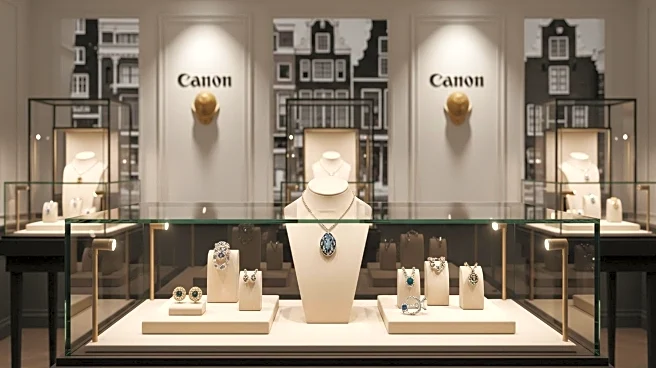What is the story about?
What's Happening?
Dutch jeweler Bibi van der Velden has opened her first flagship store in Amsterdam, marking a significant milestone for her brand as it approaches its 20th anniversary. The store, spanning 800 square feet, is located just 20 minutes from her studio gallery where she previously hosted clients. Designed in collaboration with interior designer Noa Verhofstad, the store features vaulted ceilings for a cathedral-like atmosphere on the ground floor and a '60s Mad Men vibe on the mezzanine. The store aims to offer an immersive experience, with interactive elements such as cabinets that reveal hidden spaces and a display featuring an animated alligator, a recurring motif in van der Velden's work.
Why It's Important?
The opening of Bibi van der Velden's flagship store represents a strategic move to deepen customer engagement and brand presence. By creating a unique and interactive shopping environment, the jeweler is likely to attract a broader audience and enhance customer loyalty. This development could set a precedent for other luxury brands seeking to offer more personalized and immersive retail experiences. The store's design and concept reflect a growing trend in the retail industry towards experiential shopping, which can drive foot traffic and increase sales.
What's Next?
As Bibi van der Velden's flagship store begins operations, it is expected to draw attention from both local and international customers. The store's unique design and interactive elements may inspire other luxury brands to innovate their retail spaces. Additionally, the success of this flagship could lead to further expansion or the introduction of similar concepts in other locations. The jeweler may also explore collaborations or events to maintain customer interest and engagement.
Beyond the Headlines
The flagship store's emphasis on exploration and interaction highlights a shift in consumer expectations towards more engaging and memorable shopping experiences. This trend could influence the broader retail industry, encouraging brands to rethink traditional store layouts and incorporate elements that foster customer interaction. The store's design also reflects a cultural appreciation for craftsmanship and creativity, aligning with a growing consumer preference for unique and artisanal products.
AI Generated Content
Do you find this article useful?


















